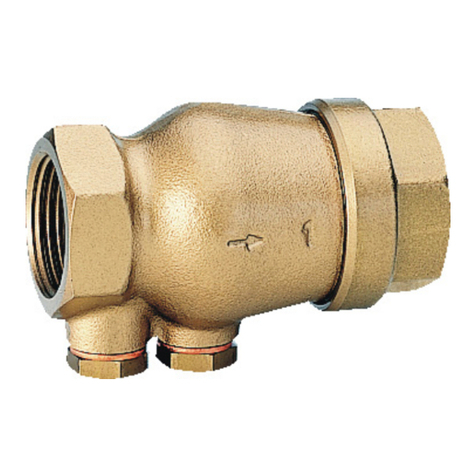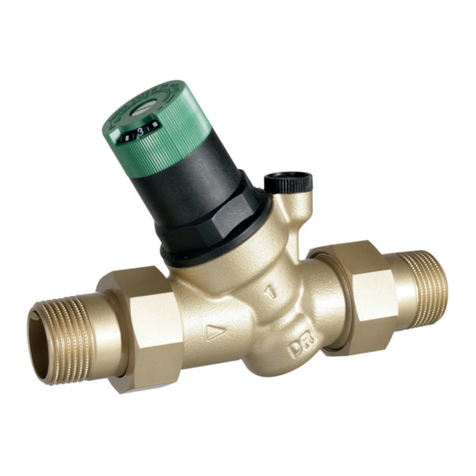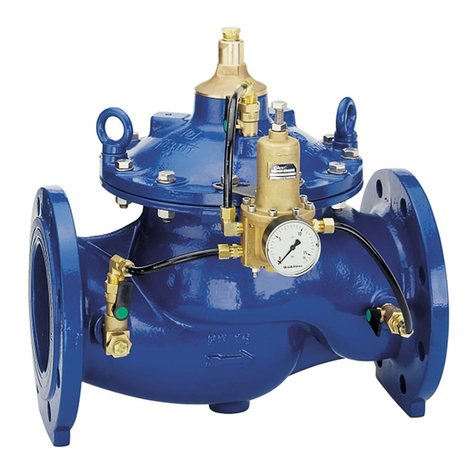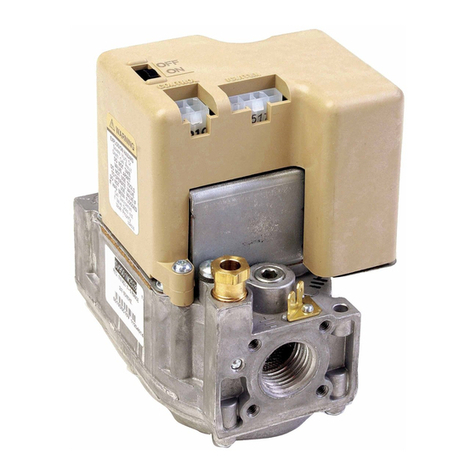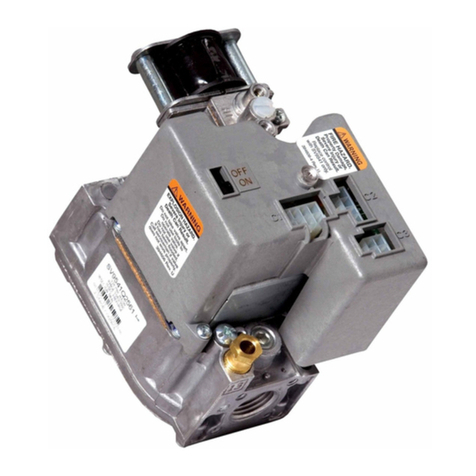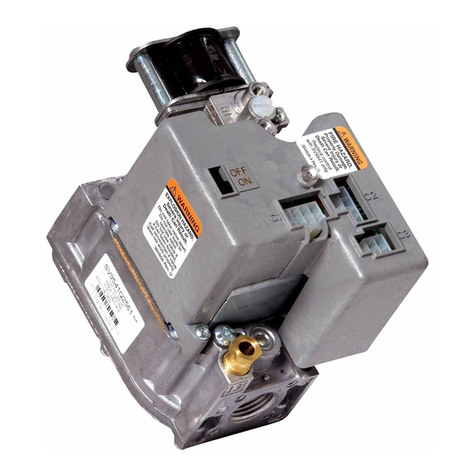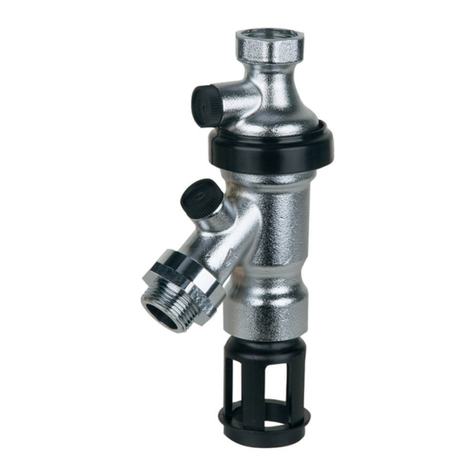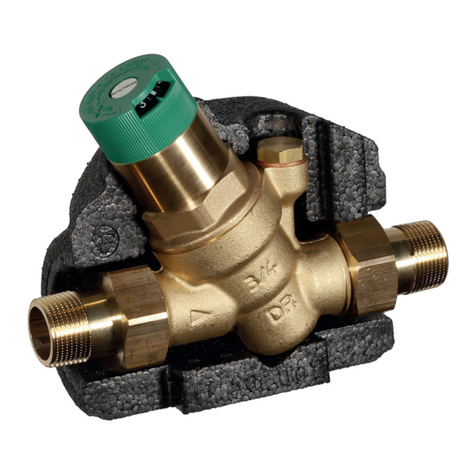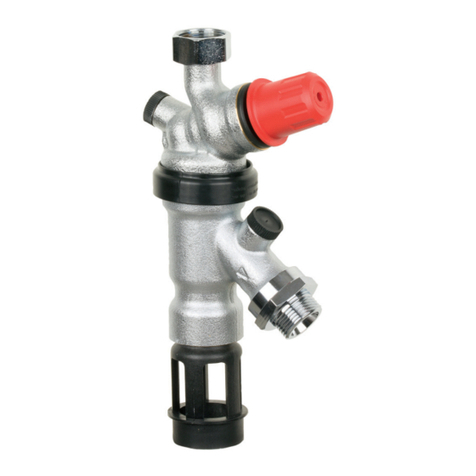
VR4300 CONTINUOUS PILOT COMBINATION GAS CONTROL
969-0683—02
IF THE PILOT BURNER FLAME WILL NOT LIGHT
1. Assure the main gas supply valve is open and the
pilot gas supply line is purged of air.
2. Attempt to light pilot burner flame following proce-
dures in Light the Pilot Burner Flame, page 6. If
pilot burner flame still will not light:
a. Check the pilot gas adjustment screw. If closed,
readjust the pilot flame.
b. Perform the Gas Leak Test at the compression
fitting. If a gas leak is detected, replace the old
compression fitting or tighten the newly
installed one. Refer to Fig. 4.
c. Assure that the pilot burner tubing or pilot
burner orifice is not clogged.
IF THE PILOT BURNER FLAME GOES OUT WHEN THE
GAS CONTROL KNOB IS RELEASED
1. Assure the gas control knob is held in at least one
minute to allow the thermocouple time to heat.
2. Check the pilot burner flame adjustment. Refer to
Adjust the Pilot Burner Flame, page 6.
3. Check the wiring between the thermocouple and
the gas control valve operator.
4. Assure thermocouple connection to the power unit
is tightened one-fourth turn beyond finger tight.
5. If pilot burner flame still goes out, measure the
open and closed thermocouple output voltage.
Compare it to the acceptable range charts in the
thermocouple specifications or in the Gas Controls
Handbook. Replace the thermocouple if voltages
are outside the acceptable range.
6. Check the power unit resistance. If above 11 ohms,
replace the gas control.
IF THE MAIN BURNER WILL NOT COME ON WITH A CALL
FOR HEAT
1. Assure the gas control knob is in the ON position.
2. Adjust the thermostat several degrees above room
temperature.
3. Use an ac voltmeter to measure the voltage across
terminals L1 and L2:
a. If no voltage is present, check the control cir-
cuit for proper operation.
b. If voltage is present, but first operator did not
click open, check for excessive inlet gas pres-
sure. If inlet gas pressure is correct, replace the
gas control.
4. Measure the open and closed thermocouple output
voltages and compare to the acceptable range
charts in the thermocouple specifications or in the
Gas Controls Handbook. Replace the thermocouple
if voltages are outside the acceptable range.
IF THE MAIN BURNER IS OVERFIRING
Adjust the gas control pressure regulator to the correct
pressure. If the regulator cannot be adjusted and supply
pressure is in the normal range, replace the gas control.
INSTRUCTIONS TO THE HOMEOWNER
FIRE OR EXPLOSION HAZARD CAN CAUSE
PROPERTY DAMAGE, SEVERE INJURY, OR DEATH
Follow these warnings exactly:
1. Pilot burner flame must be lit manually. Follow
these instructions exactly.
2. Before lighting pilot burner flame, smell around
the appliance for gas. Be sure to smell next to
floor because LP gas is heavier than air.
3. IF YOU SMELL GAS:
• Turn off the gas supply at the appliance service
valve. On LP gas systems, turn off gas supply
at the gas tank.
• Do not light any appliances in the house.
• Do not touch electrical switches or use the
phone.
• Leave the building and use a neighbor’s phone
to call your gas supplier.
• If you cannot reach your gas supplier, call the
fire department.
4. Do not force the gas control knob. Use only
your hand to push down or turn the gas control
knob. Never use any tools. If the gas control
knob will not operate by hand, the gas control
should be replaced by a qualified service
technician. Force or attempted repair may
result in a fire or explosion.
5. The gas control must be replaced in case of
any physical damage, tampering, bent
terminals, missing or broken parts, stripped
threads, or evidence of exposure to heat.
IMPORTANT:
Follow the operating instructions provided by
the manufacturer of your heating appliance. The
information below will help you in a typical gas
control application, but the specific controls
used and the procedures outlined by the manu-
facturer or your appliance may differ, requiring
special instructions.
LIGHTING THE PILOT BURNER FLAME
STOP: Read the Warnings Above.
The pilot burner flame must be lit manually. If the pilot
burner flame has gone out, follow these instructions
exactly:
1. Set the thermostat to its lowest setting.
2. Disconnect all electric power to the appliance.
3. Remove the gas control access panel.
4. Push in the gas control knob slightly and turn
clockwise to OFF.
NOTE: The gas control knob cannot be turned from
PILOT to OFF unless it is pushed in slightly. Do
not force the gas control knob.
5. Wait five minutes to clear out any unburned gas. If
you then smell gas, STOP! Follow step 3 in the
Warnings above. If you do not smell gas, continue
with the next step.
6. Remove the pilot burner access panel located
below and behind the gas control.
7. Find the pilot burner by following the metal tube
from the gas control. The pilot burner is between
the two burner tubes behind the pilot burner
access panel.
8. Turn the gas control knob counterclockwise to
PILOT.
